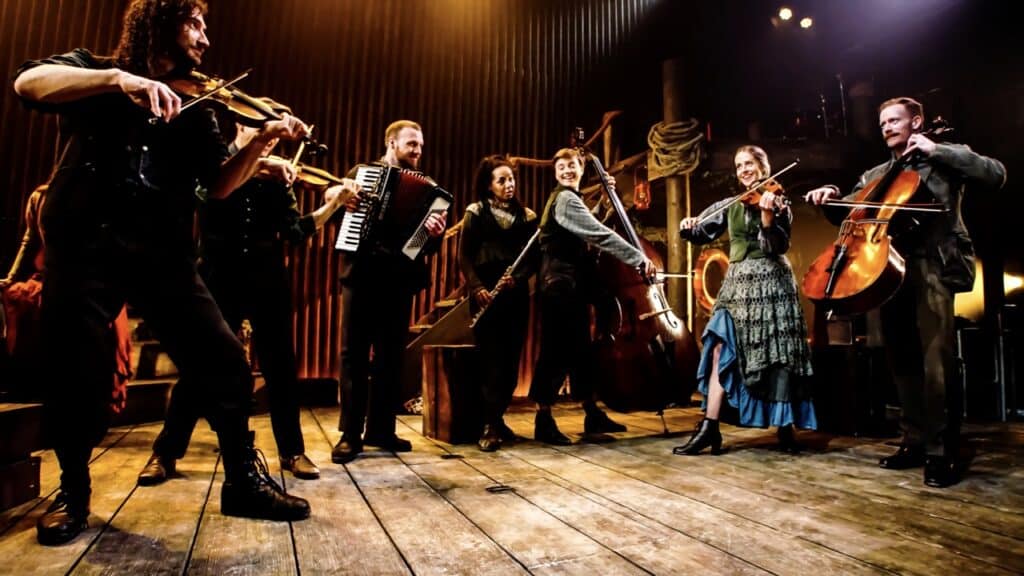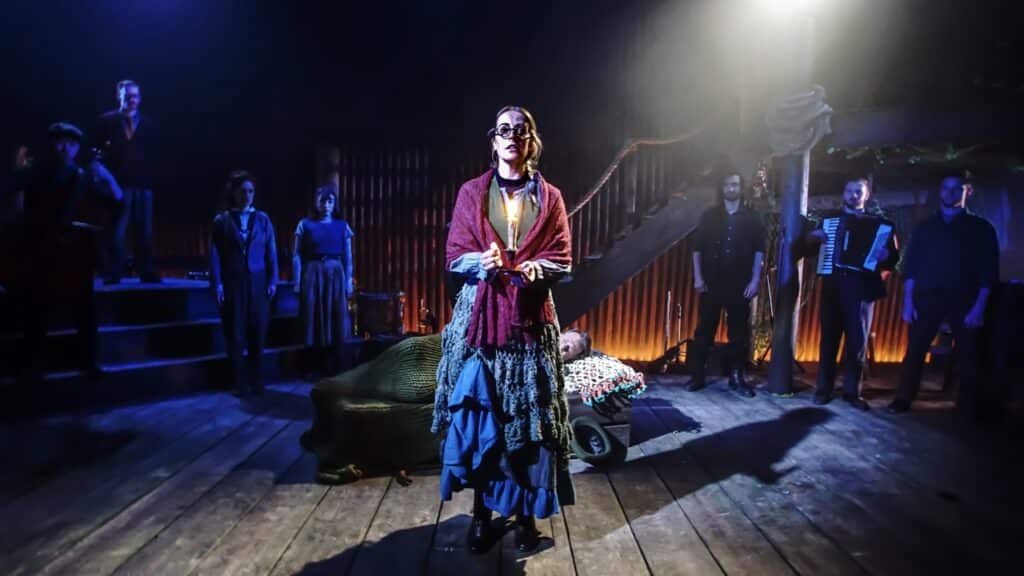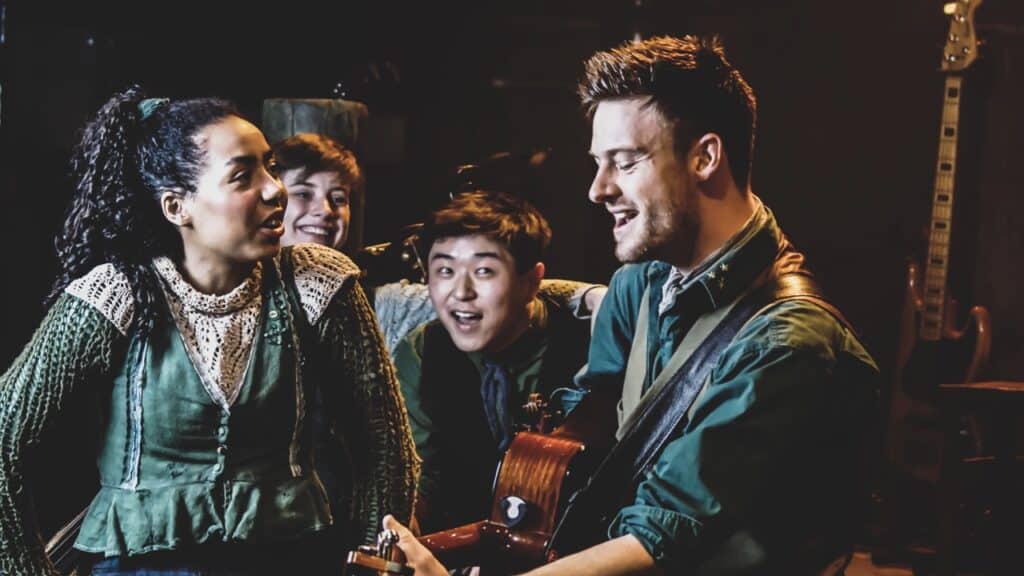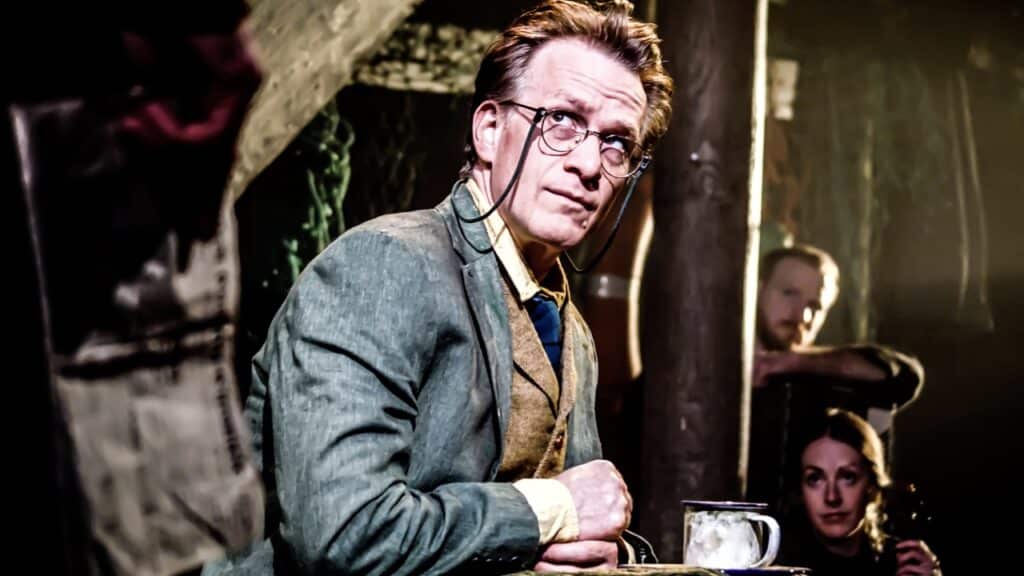Our Hires
Find out about our extensive hire services.
Tell Me More…at Southwark Playhouse: Sound Design By Autograph
The new musical production of F. Scott Fitzgerald’s classic age-reversal story opened in June 2023 at the Elephant, one of two Southwark Playhouse theatres and a new multi-functional space. Produced by ATG Productions, GBA, Gavin Kalin, Eilene Davidson, and UMEDA Arts and directed, written, and co-produced by Jethro Compton (who also designed the set) with music and lyrics by Darren Clark, the show effectively brings a rural north Cornwall coastal location into the heart of London.
Compton’s vision for the show is centered on creating a naturalistic setting for the company, complete with fishing nets, seaweed, and a stage set that captures the feel of a Cornish fishing village. The story is told by twelve actors/musicians in the guise of local people, sung in complex close harmonies, all while playing numerous instruments.

Whilst only a relatively compact space, the production requires sound reinforcement and a very specific approach to the project was needed to ensure every word said and every note played could be heard throughout the venue. Autograph’s Luke Swaffield handled the sound design and he talks about his work in Southwark:
“From a sound design perspective, the starting point was understanding the creative vision in terms of how the story was to be told. It is very much an ensemble piece with lots of close harmony and group singing throughout, with the key narrative being delivered by those 12 voices, sometimes singing in Cornish. The goal is to let the words tell the story via a transparent sound design – ultimately we don’t want the audience to realise that the show is amplified.” This is particularly evident near the start of the show, where an initially very quiet and gentle section suddenly transitions into the first big number – Luke says, “That is a really special moment because the dynamics change so dramatically, but without any obvious indication that anything is amplified.”
“The Elephant is a compact thrust theatre and its size was probably the biggest challenge overall as it impacted the design in several ways. For example, to stay with the natural feel, the producers wanted there to be no visible microphones, which is a harder trick to pull off when the audience are so close to the performers. Consequently the microphones on the actors had to go in the hairline rather than on the forehead, further wireless mics were hidden on the instruments and almost all the wired mics had to be concealed within the set. A large selection of miniature DPA microphones were employed to achieve this and all credit here goes to No2 Lucy Taylor for her expert mic hiding skills!”
The application of a fairly large wireless microphone rig was also key to achieving Luke’s creative input: “To maintain the sonic illusion that supports the story and dialogue, it was vital to have everything in the sound system so that all the various sources could be moved, placed and effected according to the mix and the various scenes. That meant 28 channels of Sennheiser wireless systems, a modest number in a larger theatre but surely a record for a space this small.”

“Also the sound system as a whole really had to fit the naturalistic aesthetic, so all the loudspeakers also had to be integrated within the set, even using 3D modeling to create designs that could accommodate the loudspeakers invisibly. We supplemented the EM Acoustics house system with some more of their products from our own inventory, specifically for foldback and some fills.”
The need for sound reinforcement goes beyond support for the voices and instruments, however: “There’s a magical element within the show that also relies on sound design. Some scenes are location-based and in them we take the audience somewhere else completely. Again, this is part of delivering the narrative and there are elemental parts where the space is transformed into the wild Cornish coast in a storm, with wind and waves crashing all around. This relies on the very discreet surround system and the placement of affected instruments and voices to deliver that essential change in environment.”
“This is actually a big show in a small space, at several points it really feels like it’s trying to burst out of the theatre! It’s a complex show too, with lots of doubling up on instruments. The cast all play several different instruments each, often within the same number, so keeping on top of who plays what and when meant not only lots of desk cues but also many foldback cues so that everyone could hear themselves regardless of where they are on stage, or what they happen to be playing at the time. This was all managed via DiGiCo’s T software running on an SD9 and frankly I can’t imagine how it could have been done any other way.” Dylan Winn-Davis, sound no1, expertly mixes the show and manages the scene changes night after night, responding to the subtle changes in the cast’s performance. “It’s a beast of mix” comments Luke “and Dylan is really doing a truly excellent job!”

Luke concludes, “This was a wonderful project in so many ways. Being involved with such an innovative re-telling of a classic tale was great fun and I was able to spend a lot of time at rehearsals getting to know the cast, developing a rapport, making sure they knew I was totally approachable and working with them to ensure their foldback mixes were what they needed. This time in rehearsals really paid off when we hit the theatre for sound checks and technical rehearsals. Throughout the process we were able to have an honest and open dialogue amongst us all. Being in rehearsals so much in the early stage of the process also allowed for collaboration with Darren Clark, the composer and orchestrator, alongside Musical Director Mark Aspinall, even modifying the score here and there to make sure the dialogue and music could work seamlessly together, with great results. Overall it was a joy to be part of the process and to design this beautiful show.”
Jethro Compton comments on his collaboration with Swaffield:
“As many sound designers who’ve worked with me over the years would confirm, I can be incredibly particular about the use of sound within my shows – it’s an essential part of my toolbox when it comes to creating a stage production – so working for the first time with a sound designer aways brings me a great deal of anxiety.”
“When it came to working with Luke on …Button, that anxiety was totally unwarranted. It quickly became apparent that I was in astonishingly safe hands. His technical knowledge of sound, supported by the incredible team at Autograph, was really only the beginning of this process. It became clear from our very first meetings that Luke’s vision for the use of sound within the production was completely aligned with the ambition I had for the project. From this, I quickly developed a trust in Luke’s creative processes – and was constantly thrilled by his use of sound to create the world of Cornwall and surprised to observe the ways in which he used sound to dramaturgically guide the audience through the story.”
“I’m incredibly grateful for each and every contribution Luke has made to the production, and I really hope this is only the beginning of our creative partnership.”

Photo credit for all images: Jethro Compton
Equipment summary:
House system: EM Acoustics R8s, S15s, EMS-51Xs, DQ10D amplifiers.
Additional equipment supplied by Autograph:
EM Acoustics EMS-41s, EMS-61s, EMS-81s
Powersoft T604 amplifiers
DiGiCo SD9-T digital audio mixing system
Sennheiser 6000-Series / EM3732 wireless systems
DPA microphones